Google Nexus 4 Review - Google's new Flagship
by Brian Klug on November 13, 2012 8:45 AM EST- Posted in
- Smartphones
- LG
- Android
- Mobile
- APQ8064
- Nexus 4
- Android 4.2
- MDM9215
Battery life in the Nexus 4 is a big concern for many, especially since the Nexus 4 isn’t designed to have a user replaceable battery. What’s inside is a 2100 mAh 3.8V battery which is 8.0 watt-hours. I had been wondering for a while what the chemical compound used in the 3.8V battery cells we’re seeing emerge was, and finally got a tad more info at least about the LG Chem approach. This is the higher voltage chemistry from LG Chem which is Lithium Cobalt Oxide (LiCoO2) based and includes electrolyte additives to prevent gas generation in the cell which affects lifetime during high temperature periods. Although getting the back off of the Nexus 4 is relatively easy and requires just removing two Torx 4 screws and prying up on the plastic, I doubt anyone is going to make a back to accommodate an extended battery due to the presence of 4 antennas which are integrated into the back cover.
The Nexus 4 incorporates wireless charging into that back alongside NFC. For wireless charging the Nexus 4 uses a TI BQ51051b wireless power Li-Ion charger receiver. I’ve been pretty remiss in looking into wireless charging and actually trying it myself, so I went ahead and bought a two-position Energizer Qi compliant charging mat.
The Nexus 4 is Qi 1.1 wireless charging forum compliant, so any charger that is Qi compliant or includes the logo will charge it. Aligning the Nexus 4 on the Energizer mat is a bit tricky since the surface is slick and angled down, and the back of the Nexus 4 is primarily glass, but it isn’t difficult after you know where to align. The Nexus 4 charges from fully discharged to completely charged in 3.033 hours on the Qi mat, which is basically the same charge time as I saw off of microUSB on a BC 1.2 charger.
In Android you’ll see Charging (Wireless) when this mode is employed. I used the Palm Pre touchstone charger a lot back in the day and saw that get pretty hot during a charge cycle. The Nexus 4 doesn’t get nearly as warm. I’ve noticed that at the top of the charge cycle you’ll see the Nexus 4 selectively draw power from the charging dock since there doesn’t seem to be an equivalent trickle charge mode or something, but this is normal.
Battery Life
I’ve had the chance to run more battery life tests on the Nexus 4, and run the cellular test a few more times. The results are quite consistent and we don’t see that result change very much at all. I’ve also added the call time test and tethering results.
We regularly load web pages at a fixed interval until the battery dies (all displays are calibrated to 200 nits as always). The differences between this test and our previous ones boil down to the amount of network activity and CPU load.
On the network side, we’ve done a lot more to prevent aggressive browser caching of our web pages. Some caching is important otherwise you end up with a baseband test, but it’s clear what we had previously wasn’t working. I’ve made sure that despite the increased network load, the baseband still has the opportunity to enter its idle state during the course of the benchmark, we’re not destroying the RRC states with too aggressive of a load time.
We also increased CPU workload along two vectors: we decreased pause time between web page loads and we shifted to full desktop web pages, some of which are very JS heavy. The end result is a CPU usage profile that mimics constant, heavy usage beyond just web browsing. Everything you do on your smartphone ends up causing CPU usage peaks - opening applications, navigating around the OS and of course using apps themselves. Our 5th generation web browsing battery life test should map well to more types of smartphone usage, not just idle content consumption of data from web pages.
As always we test across multiple air interfaces (3G, 4G LTE, WiFi), but due to the increased network load we actually find that on a given process technology we see an increase in battery life on faster network connections. The why is quite simple to understand: the faster a page is able to fully render, the quicker all components can drive down to their idle power states. All Android tests use Chrome and 5GHz WiFi unless otherwise listed.
The tethering test still consists of four tabs of the webpage tests in conjunction with a 128 kbps streaming MP3 radio station over the smartphone’s personal WiFi hotspot.
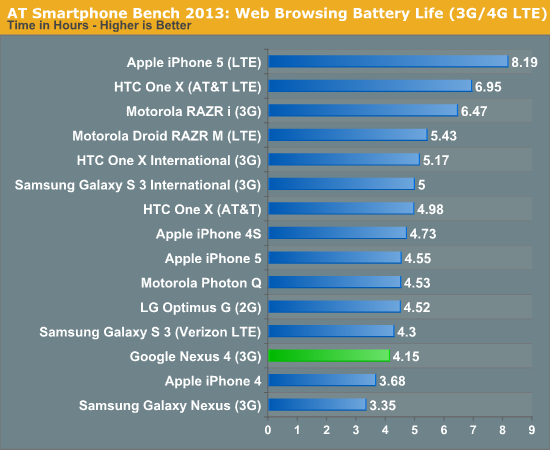
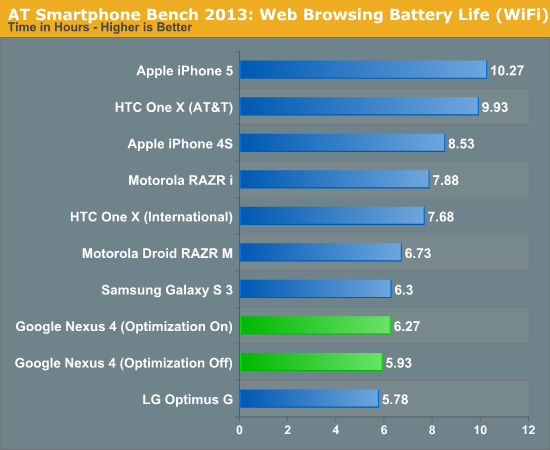
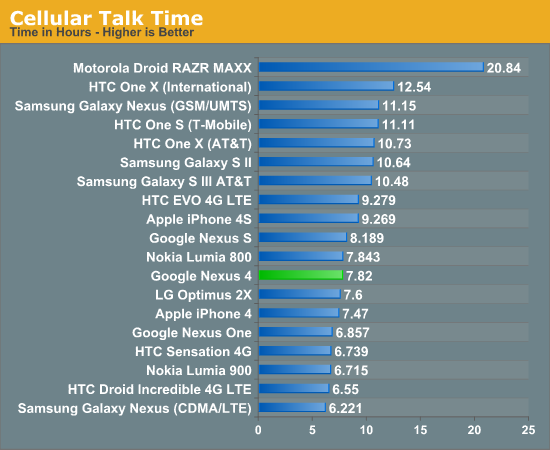
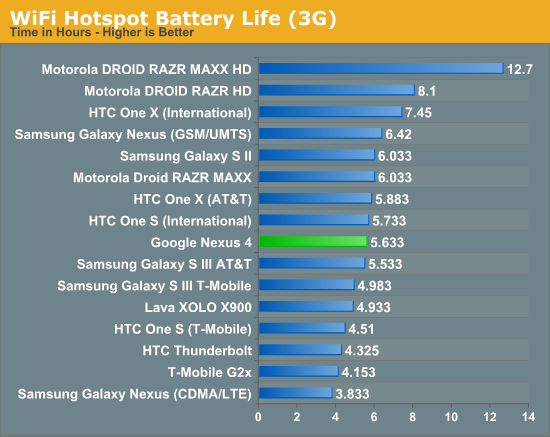
I've run and re-run the battery life tests on the Nexus 4 and they haven't changed since our preview a whole bunch. The result is battery life that isn't really chart topping, yet in my time with the Nexus 4 I haven't really been want for more battery life at any point. I'm able to get through a single day with the device set on auto brightness.



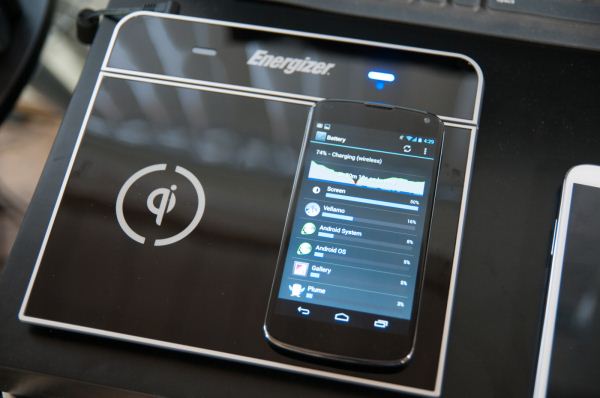

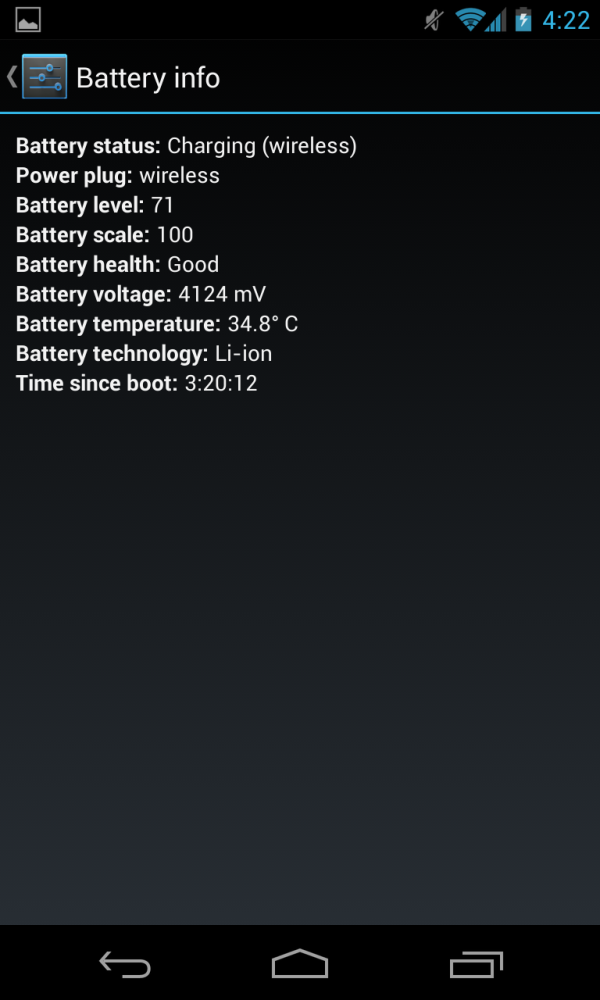








188 Comments
View All Comments
numberoneoppa - Tuesday, November 13, 2012 - link
Lovely review, Brian, as usual, but I have a question. Forgive me if I just glanced over this, but have you run your benchmarks using the newest OTA which rolled out over the last day or are these running the same software as those posted earlier in the month? In any case, it would be interesting to see if there are any changes in the XML file which seems to specify temperature shelves.Jorange - Tuesday, November 13, 2012 - link
Hi Brian,Can you please confirm that all GL Benchmark tests are run serially for all devices?, as this places them under a greater thermal load, then running the benches individually.
Brian Klug - Tuesday, November 13, 2012 - link
I do whenever possible, always. The issue is what happens when devices crash out before a full run (Optimus G) which then forces my hand to do this piece-by-piece kind of testing and reassemble a whole run.-Brian
MadMan007 - Tuesday, November 13, 2012 - link
You should note which devices have 'assembled scores' versus straight runs in your charts then. An asterik would do.xTRICKYxx - Tuesday, November 13, 2012 - link
By far the best Nexus 4 review; bar none.Kernel developers will easily raise the thermal throttling limit to a much higher temperature, but it is obvious there is a temperature issue.
suhan - Tuesday, November 13, 2012 - link
why is it that you don't use geekbench to measure the actual performance of the device?tuxRoller - Tuesday, November 13, 2012 - link
Because it is closed source thus we dont know exactly what paths it takes (meaning it could disproportionately harm one particular device over another)?Hell, do we need even know what compiler they use? Knowing that and the flags used would certainly be very useful.
HisDivineOrder - Tuesday, November 13, 2012 - link
...this site used to be about custom-built computers?We'd get driver reviews, we'd get hardware other than video cards, motherboards, and CPU's reviewed, we'd get the skinny on new custom PC hardware that was coming...
I'm waxing nostalgic here. I miss those days, I think. These smartphone reviews are just beginning to bore me to tears. Maybe I'm just old, but I miss the good ol' days. Back when phones were something we just lived with rather than something people seem to obsess over now.
Back when having the latest and greatest in computing was more about smart hardware selection and less about going to the store, slapping down your cc, and saying, "Gimme your best, barkeep!"
Medikit - Tuesday, November 13, 2012 - link
I remember those days really well. Mobile computing is the future of the industry. Furthermore Anandtech still reviews computer cases, HTPCs, and the latest, greatest hardware. I like to think of it as the best of both worlds.Alexo - Thursday, November 15, 2012 - link
> Mobile computing is the future of the industry."Mobile computing" will not get truly mobile until we get decent battery life.
Meanwhile, AnandTech keeps lauding devices that have more computing power than most of us ever utilize at the expense of battery life (not to mention non-user-changeable batteries, throttling, etc.)